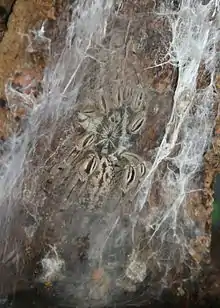Stromatopelminae
The Stromatopelminae are a subfamily of tarantulas native to West Africa and part of Central Africa. The subfamily was first proposed by Günter Schmidt in 1993.[1]
| Stromatopelminae | |
|---|---|
 | |
| Heteroscodra maculata | |
| Scientific classification | |
| Domain: | Eukaryota |
| Kingdom: | Animalia |
| Phylum: | Arthropoda |
| Subphylum: | Chelicerata |
| Class: | Arachnida |
| Order: | Araneae |
| Infraorder: | Mygalomorphae |
| Family: | Theraphosidae |
| Subfamily: | Stromatopelminae Schmidt, 1993 |
| Genera | |
|
See text. | |
Taxonomy
The subfamily Stromatopelminae was first proposed by Günter Schmidt in 1993.[1] The genera he included had been placed in the subfamily Eumenophorinae by Raven in 1985.[2] Schmidt excluded them as they did not have the typical stridulating organ on the coxa and trochanter of the palps and legs which are present in Eumenophorinae.[1] The subfamily was recovered as monophyletic in both a 2018 and a 2019 study, sister to the subfamily Harpactirinae.[3][4]
Genera
Schmidt included two genera,[1] both found in tropical West and Central Africa.[5][6] Both genera were included in the 2019 study that found the subfamily to be monophyletic.[4]
- Heteroscodra Pocock, 1899
- Stromatopelma Karsch, 1881
Gallon in 2005 also placed the monotypic genus Encyocratella in the subfamily.[7] The genus was not found to be part of the subfamily in a 2018 Master's dissertation, which treated it as incertae sedis as regards subfamily.[8] It was not included in the 2018 and 2019 studies which found the subfamily to be monophyletic.[3][4]
Distribution and habitat
These arboreal tarantulas are often found dwelling in palm trees native to the West African region.
References
- Schmidt, G. (1993), "New results in the systematics of Theraphosidae (Araneida, Mygalomorphae)" (PDF), Bolletino dell'Accademia Gioenia di Scienze Naturali, Catania, 26 (345): 311–321, retrieved 2021-01-15
- Raven, Robert J. (1985), "The spider infraorder Mygalomorphae (Araneae) : cladistics and systematics", Bulletin of the AMNH, 182, hdl:2246/955, retrieved 2016-01-18
- Lüddecke, Tim; Krehenwinkel, Henrik; Canning, Gregory; Glaw, Frank; Longhorn, Stuart J.; Tänzler, René; Wendt, Ingo & Vences, Miguel (2018), "Discovering the silk road: Nuclear and mitochondrial sequence data resolve the phylogenetic relationships among theraphosid spider subfamilies", Molecular Phylogenetics and Evolution, 119: 63–70, doi:10.1016/j.ympev.2017.10.015, PMID 29104141
- Foley, Saoirse; Lüddecke, Tim; Cheng, Dong-Qiang; Krehenwinkel, Henrik; Künzel, Sven; Longhorn, Stuart J.; Wendt, Ingo; von Wirth, Volker; Tänzler, Rene; Vences, Miguel & Piel, William H. (2019), "Tarantula phylogenomics: A robust phylogeny of deep theraphosid clades inferred from transcriptome data sheds light on the prickly issue of urticating setae evolution", Molecular Phylogenetics and Evolution, 140 (106573): 106573, doi:10.1016/j.ympev.2019.106573, PMID 31374259
- "Gen. Heteroscodra Pocock, 1900", World Spider Catalog, Natural History Museum Bern, retrieved 2021-01-15
- "Gen. Stromatopelma Karsch, 1881", World Spider Catalog, Natural History Museum Bern, retrieved 2021-01-15
- Gallon, Richard C. (2005), "Encyocratella olivacea Strand, 1907, a senior synonym of Xenodendrophila gabrieli Gallon, 2003 (Araneae: Theraphosidae: Stromatopelminae) with a description of the male", Zootaxa, 1003 (1): 45–56, doi:10.11646/zootaxa.1003.1.3
- Gil, Yeimy Lizeth Cifuentes (2018), Revisão taxonômica e análise cladística dos gêneros de tarântulas arborícolas Psalmopoeus Pocock, 1985 e Tapinauchenius Ausserer, 1871 (Araneae: Theraphosidae: Aviculariinae) (PDF) (Master's thesis), Instituto de Biociências, Letras e Ciências Exatas, Universidade Estadual Paulista "Júlio de Mesquita Filho", retrieved 2021-01-15